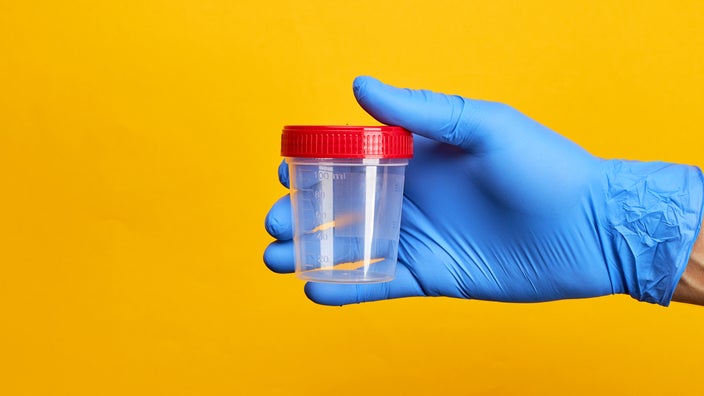
How to Collect a Stool Sample at Home in 5 Easy Steps
Key takeaways:
Stool tests can help your healthcare provider diagnose conditions involving the digestive tract.
Your healthcare provider will give you a kit with all the supplies you need to make collecting a stool sample convenient.
It’s important to keep your stool sample free from contamination. Always wash your hands with soap and water after handling stool.

There are several medical conditions that may prompt your healthcare provider to ask you for a stool sample. Stool samples are helpful when looking for certain infections or inflammation in the digestive system.
If you’re asked to provide a stool sample, have no fear. Sending in a stool sample will not require you to stay in the hospital or take any medications. And you can do it from the comfort of your home.
How should you properly collect a stool sample?
If you’ve been asked to collect and turn in a stool sample, you’ll be given a kit to collect the stool. The kit should have a specimen container or cup to collect the stool, as well as a submission bag. The kit may also include gloves, a disposable potty (to catch the stool), a label with your information, and a spatula or spoon.
Follow these five steps so that you can collect a proper stool sample that your healthcare provider can use:
If your kit comes with a potty, place the potty in the toilet (under the lid) to catch stool before it hits the toilet. If not, you can use a clean, empty container.
Have a regular bowel movement. Try not to get any urine or toilet water in the specimen cup. The goal is to collect only stool.
Use the spoon or spatula provided to transfer the stool to the specimen container or cup that was given to you.
Close the container once it’s about half full. This will keep the contents sterile (clean) to make sure the stool doesn’t get contaminated.
Always remember to wash your hands with soap and warm water after using the bathroom.
How do you store a stool sample?
Once you have transferred the stool to the specimen cup and sealed the container, you’re ready for storage. If your kit came with a plastic bag, place the container in the bag and seal it. If you didn’t get a bag, you can use a resealable bag and seal it.
In general, the earlier you submit your stool to the lab or hospital, the better. This is to ensure that the test results are accurate.
If you’re not returning your stool sample immediately, you’ll have to store it in a refrigerator. Your healthcare provider should tell you how long your stool can be stored in a refrigerator before it’s returned. If you’re storing the specimen in the refrigerator, make sure it’s in a sealed bag and as far away from food as possible.
WHAT TO READ NEXT
How do you take a stool sample if you can’t poop?
It can be difficult to poop on demand, especially if you’re constipated. If you can’t poop for your stool sample, try eating some fiber. Increasing your fiber to 25 g to 35 g per day will improve any constipation. Many foods like fruits, vegetables, nuts, and beans are high in fiber.
Dehydration can also make it hard to poop. Try increasing how much water you drink to help soften your stools. There’s no hard-and-fast rule on how much water you need each day. Your healthcare provider can help you figure out how much you need to be drinking.
If these dietary changes don’t help you poop, talk with your healthcare provider about suggestions for providing a stool sample.
Who needs to collect a stool sample?
There are many medical conditions that can require a stool sample. If your healthcare provider is worried about infection or inflammatory bowel disease (IBD), they may order a stool sample.
Talk with your healthcare provider about the need to have your stool tested if you have any of the following symptoms:
Crampy abdominal pain
Blood in your stools (bright red blood)
Mucus in your stools
Bloating
Excessive belching
Watery diarrhea
What tests are done on a stool sample?
In general, stool samples can help your healthcare provider run tests to look for infectious or inflammatory conditions, or signs of colon cancer. Common stool sample tests include:
Fecal occult blood or fecal immunochemical test (to screen for blood in the stool from conditions like colon cancer, polyps, or IBD)
Helicobacter pylori (to look for the common ulcer-causing bacteria)
Clostridioides difficile (C. diff)
Stool culture (looking for any other bacteria present)
Parasite testing
Fecal fat testing (to look for extra fat in the stool that wasn’t absorbed)
The bottom line
If you’ve been asked to submit a stool sample, don’t worry. You’ll receive a kit with everything you need to collect your poop so it’s not complicated. Try to avoid any type of contamination of your specimen by keeping everything (except stool) out of the sterile container. The sooner you turn your specimen into the lab, the better and more accurate your results will be. Stool sample tests can help your healthcare provider make better decisions about your diagnosis or care. Talk with your healthcare provider if you have any questions about the need for a stool sample.
References
Anti, M., et al. (1998). Water supplementation enhances the effect of high-fiber diet on stool frequency and laxative consumption in adult patients with functional constipation. Hepatogastroenterology.
Centers for Disease Control and Prevention. (2016). Stool specimens – specimen collection.
National Health Service. (2023). How should I collect and store a poo (stool) sample?





